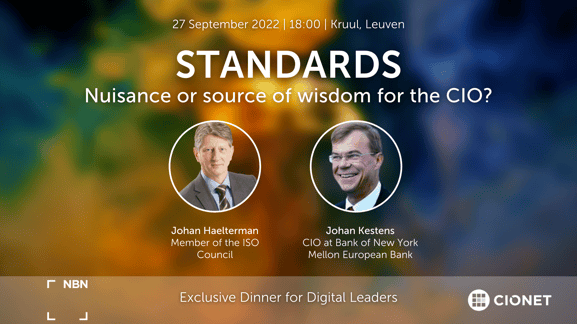.png)
Are 'standards' an annoying headache or a source of wisdom? That was the key question that CIONET, in collaboration with partner NBN, put to a dozen CIOs. Guest speakers at the roundtable were: Johan Kestens, today Head of Information Security International at the Bank of New York, but once at SWIFT responsible for the team working around standards, and next to him another Johan: Johan Haelterman, CEO of NBN, the body responsible for developing and selling standards in Belgium.

The standard: two meanings, three historical periods

Johan Kestens gave a historical-philosophical introduction about 'standards' as a teaser to open the debate. According to Johan, standards have two meanings that are also connected. In the Roman army, the standard was a badge of honour, a rallying point and a landmark on the battlefield. Throughout history, standards have remained symbols of armies, kings and heads of state and can still be found in flags and coats of arms. They are symbols of affiliation or commitment. The other meaning of a standard is a convention, an agreement concerning a particular way of working. This covers sizes, weights, dimensions, technological or other choices that allow collaboration or facilitates trade. Such standards emerged during the industrial revolution when 'systems' were invented. After all, systems require things to fit together to enable connections and interoperability. The standardisation of nuts and bolts is still an example that captures the imagination.
Johan Kestens sees three historical phases in the evolution of the use of standards. The first phase he describes as the 'defensive' phase. The difference in rail track gauges between European countries illustrates this. The requirement to change trains at border crossings was motivated by the strategic consideration of preventing enemy forces to use railroads when invading.
Johan refers to the next phase as 'selfishness'. Everyone remembers the historic battle between Philips on the one hand, who patented a Video Compact Cassette, known as Video-2000, versus Matsushita and Japan Victor Company and its Video Home System (VHS) and finally, Sony, which swore by its Betamax. Ultimately, the VHS system beat both Video-2000 and the Betamax system as a universal format. The same dynamics played out around the development of colour television, compact disc, DVD and other technological innovations where companies fought a battle to impose their solution as the standard to gain market control... However, history shows that such standards get displaced over time by innovations.
-png.png?width=396&name=Untitled%20design%20(21)-png.png)
The third stage in this evolution is the 'network' stage. In a network, standards are a catalyst for innovation. It is a way of mobilising the brainpower
of the network. With the introduction of the Internet in the late 20th century, the world became a networked economy. And a network works according to different economic laws. Metcalfe's law says that the value of a network increases quadratically with the number of connected devices (now mostly 'users'). And standards played a unique role as an 'enabler' of the digital global network economy. Internet standards were and still are mainly the work of a small and little-known group of about 25 international specialists (Internet Assigned Numbers Authority) doing so on a voluntary basis. When the Internet started to grow exponentially, it soon became clear that the prevailing internet protocol IPv4 (32-bit), with its 4.3 billion available IP addresses, was not future-proof. IPv6 (128-bit) was accepted as a standard design in December 1998. The Internet service providers and enterprises activated permanent IPv6 on 6 June 2012, which became the Internet standard on 14 July 2017. With IPv6, an almost unlimited number of addresses became available (10 to the power of 48). This deliberate switch to the new internet standard was a non-event for most people. However, one cannot underestimate its impact. The introduction of the PC and the development of the Internet have undoubtedly played a crucial role in the explosive, worldwide growth of the digital economy, thus contributing to a better world. Figures relating to the evolution of global living standards show an apparent hockey stick in the 1980s and 1990s when the digital economy accelerated. In one century, the proportion of the world's population living below the poverty line fell from 80% to 12% today (source: World Bank). Most of this evolution happened in the last 30 years, and technology is likely a big catalyst.
NBN, still little known, developer and disseminator of standards
As our 'tour de table' showed, NBN is still little known among companies. Johan Haelterman, CEO of NBN, therefore sees it as his task to work on evangelisation through initiatives such as these. NBN's mission is to encourage companies and organisations to help develop standards on the one hand and to make optimal use of them on the other. Today, NBN has a portfolio of more than 42,000 standards. And more than 1,000 are added every year. Both in our professional and private lives, standards are everywhere. Sometimes clearly visible, like the A4 format or the kilogram, sometimes somewhat behind the scenes, like standards relating to the Sustainable Development Goals of the United Nations. The different types of standards have one thing in common: they record agreements on good workmanship for products, services or processes. Users apply standards voluntarily to raise their organisation to a higher level and reap the benefits of experts' knowledge and know-how. Sometimes standards are even referred to in contracts or regulations, giving them a binding character. European regulations, for example, regularly refer to standards instead of talking about specific technologies, for instance, in the debates around topics such as the correct use of artificial intelligence, machine safety, interference between electronic devices, safety of toys,…

How are standards created?
Standards creation is an 'open' process. Anyone can participate in it. And anyone can initiate the process and ask to develop a standard (or have it developed). Specialists from various organisations, from commercial companies over research institutes to public authorities and NGOs, meet in standards committees. In these committees, experts work out best practices in the most diverse fields. In other words, the process happens through a self-controlling community, including the cycles of reviews, feedback and validations. Of course, major industry players participate in this process, and lobbying takes place, but this is done in full transparency.
Moreover, there are also consumer organisations involved that monitor consumer interests. And finally, each country has its 'standardisation body'- such as NBN in Belgium that acts as the Belgian knowledge centre for all activities related to standardisation. NBN plays a societal role by helping
companies, consumers, public authorities and other stakeholders to strive for greater quality within an international competitive context. It does so by offering services related to the development, publication, dissemination and use of standards. Publication of those standards initially took the form of physical documents. In addition, they also come in PDF or XML format. Today, they are offered on state-of-the-art knowledge platforms. And projects are underway to make them "SMART": Standards that are Machine Applicable, Readable and Transferable.
Are standards a brake or an engine of innovation?

Whether standards are a brake or an engine of innovation is a very pertinent question, according to Johan (Haelterman). Standards have a lifecycle anyway. If a standard is not updated in time, it can be a brake on technological development (for example, the ISDN or ATM standards in question). Hence, standards are a living matter continuously tinkered with by standards committees worldwide. There are also situations where standards have to serve conflicting interests: on the one hand, protecting the user by making backward compatibility mandatory, a requirement that at the same time can also have an inhibiting effect on the progress of the technology in question. In general, one can say that standards sometimes make radical innovation more difficult but, on the other hand, facilitate incremental innovations by making already available technological components interoperable. Innovation and standardisation are somewhere yin and yang, two forces that balance each other.
Standards, as a distilled form of knowledge and expertise, can be a resource on which companies can graft their knowledge management systems.NBN offers its stakeholders this access to knowledge. But how far are the organisations around the table in their knowledge management systems?
When asked, a few referred to departments - such as legal or HR - using external specialised knowledge platforms, but most still described a genuine company-wide knowledge management system as a distant ambition. Projects in that direction do exist. Unfortunately, these often get stuck at the level of data or, at best, information management systems. Everyone agrees that this is a process of qualitative steps that starts with data and should then lead to information management, insights management, knowledge management and maybe even, one day, wisdom management. Everyone knows the steps. How to put it into practice is another matter.
Nevertheless, it is a business criticality: the organisations around the table are collections of knowledge workers. Consequently, their real value is in the heads of a few experienced experts who can get sick, leave the company and age. The cynical thing is that they are all well aware of this, but few take steps to deal with it, let alone have a conclusive (proactive) approach. In fact, practice shows that in larger organisations with heavy investment in this kind of system - with documentation, video recordings, podcasts... - recourse to it is very scarce. This has everything to do with corporate culture. For example, in (academic) hospitals, there is a tradition of sending people in training along with the most experienced colleagues. Companies rarely provide this. However, people are naturally motivated to share their knowledge with others. Sharing knowledge means appreciation and satisfaction. It should therefore be an intrinsic part of everyone's job. Apparently still an unexplored area where organisations like NBN can play a pioneering role.
These Stories on CIONET Belgium
No Comments Yet
Let us know what you think